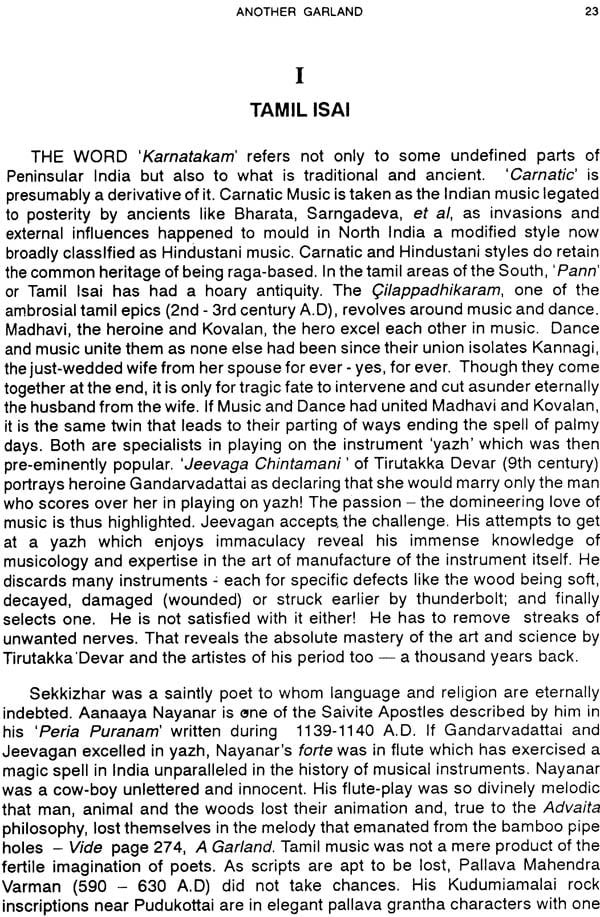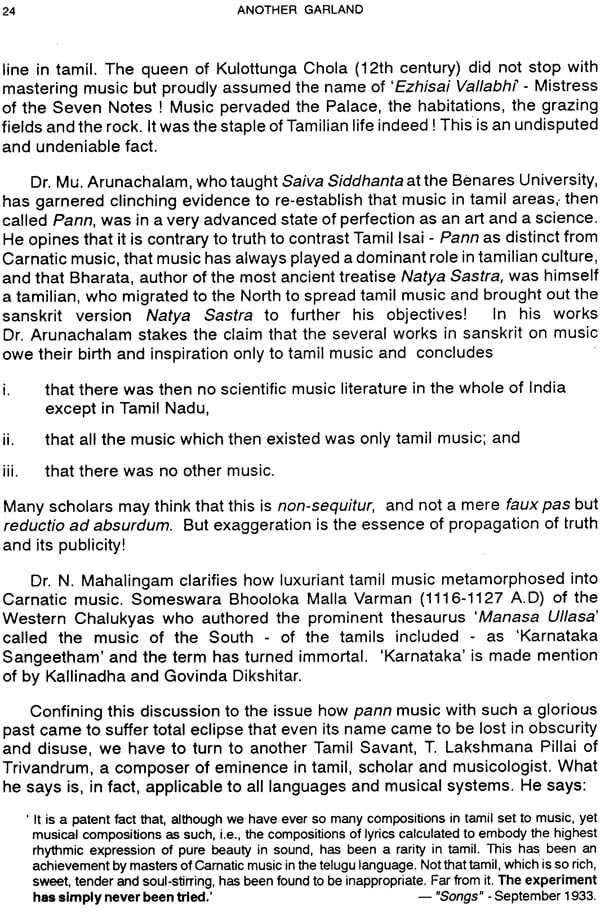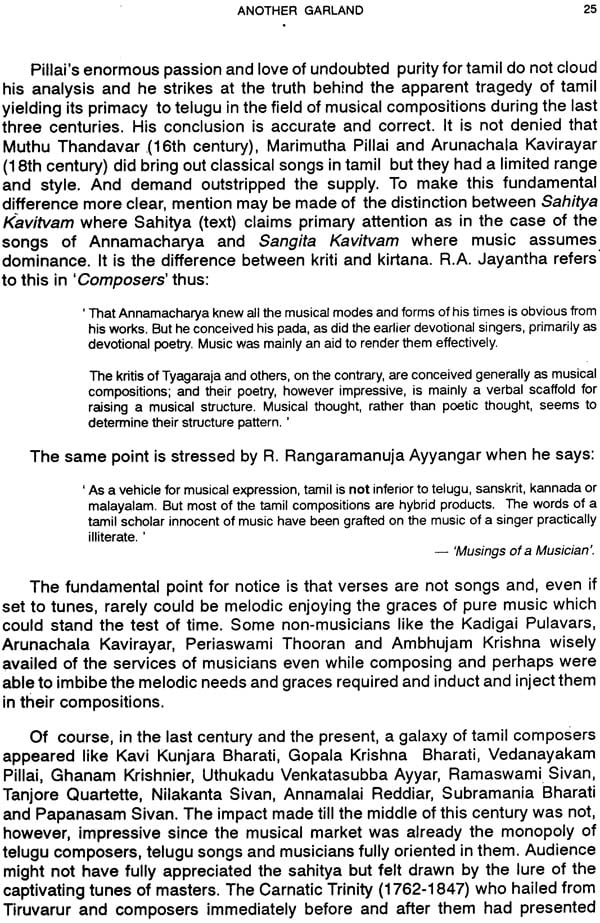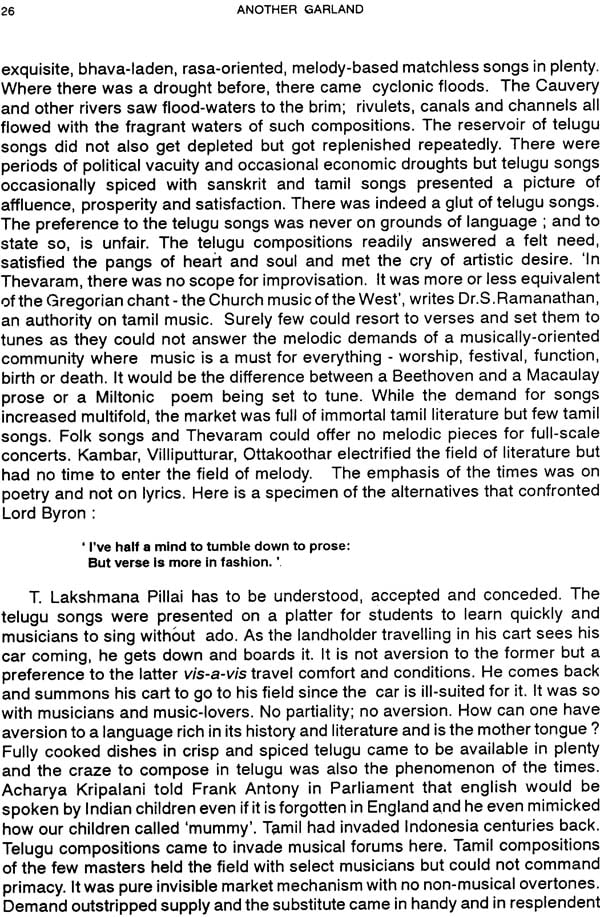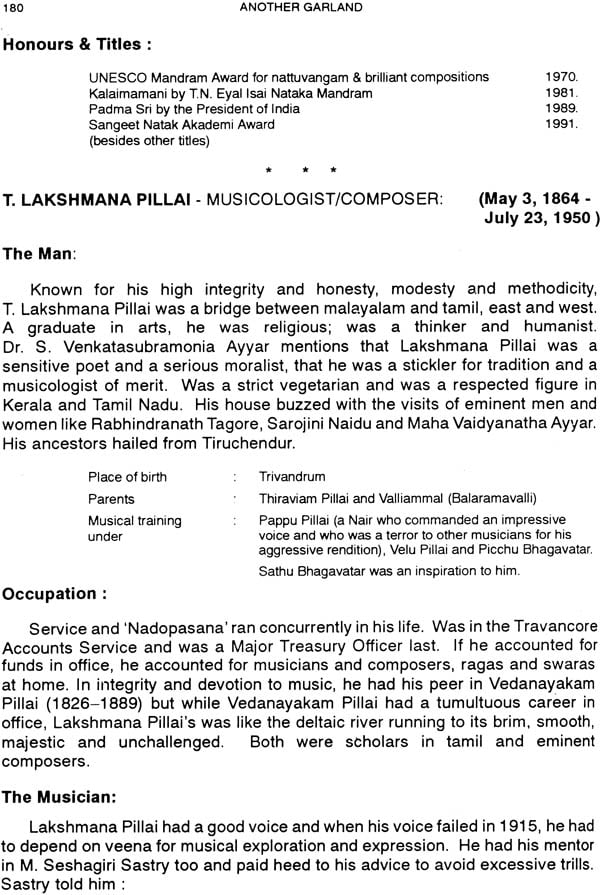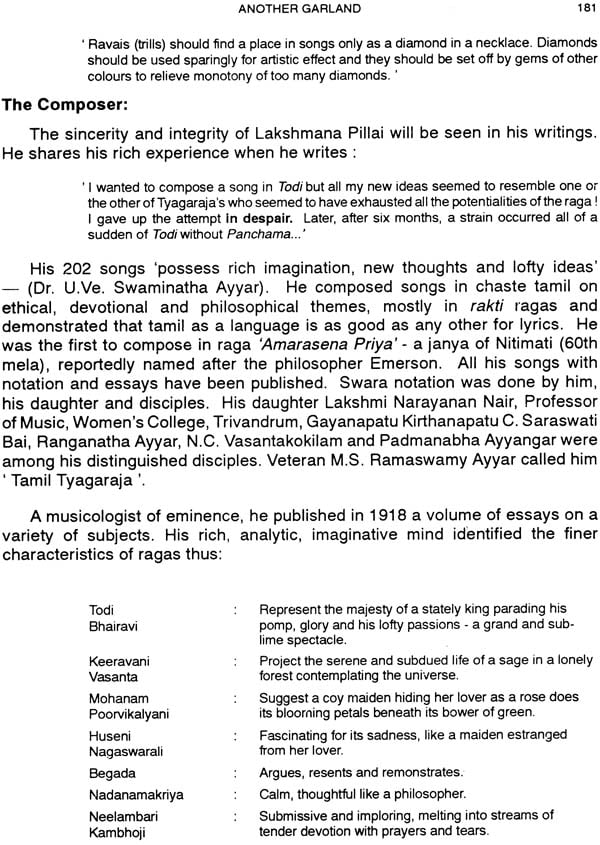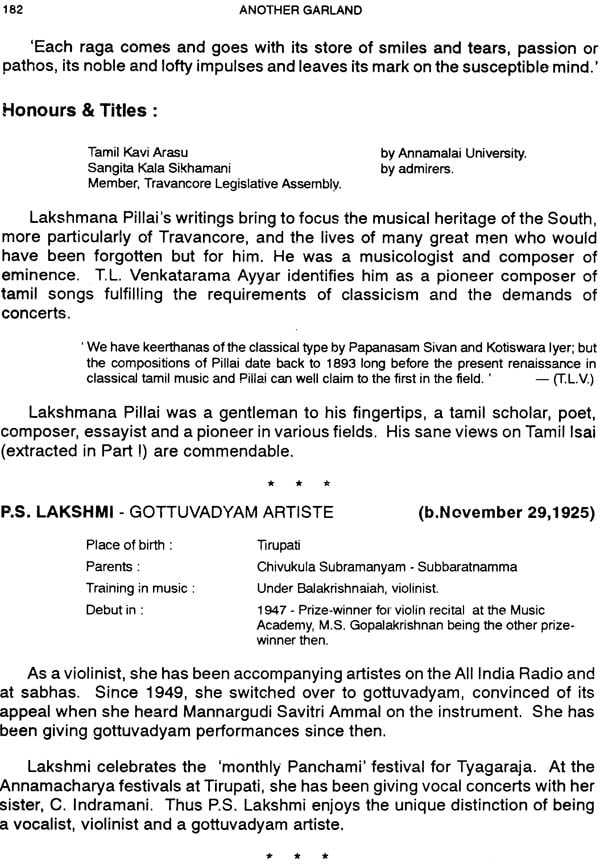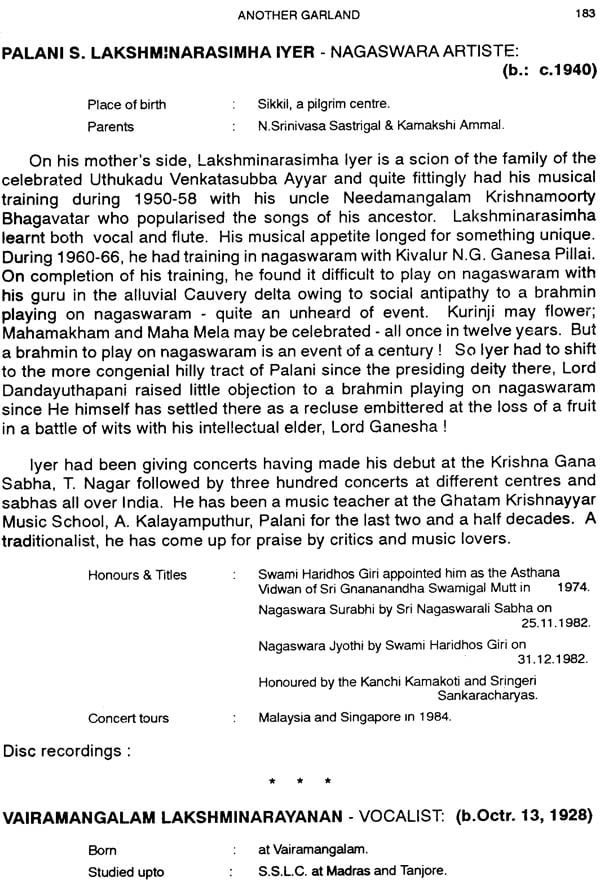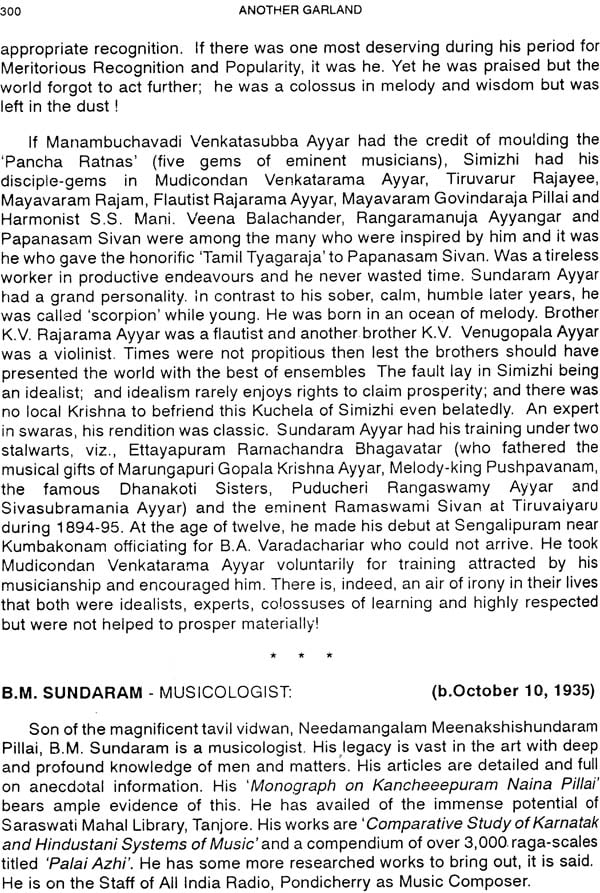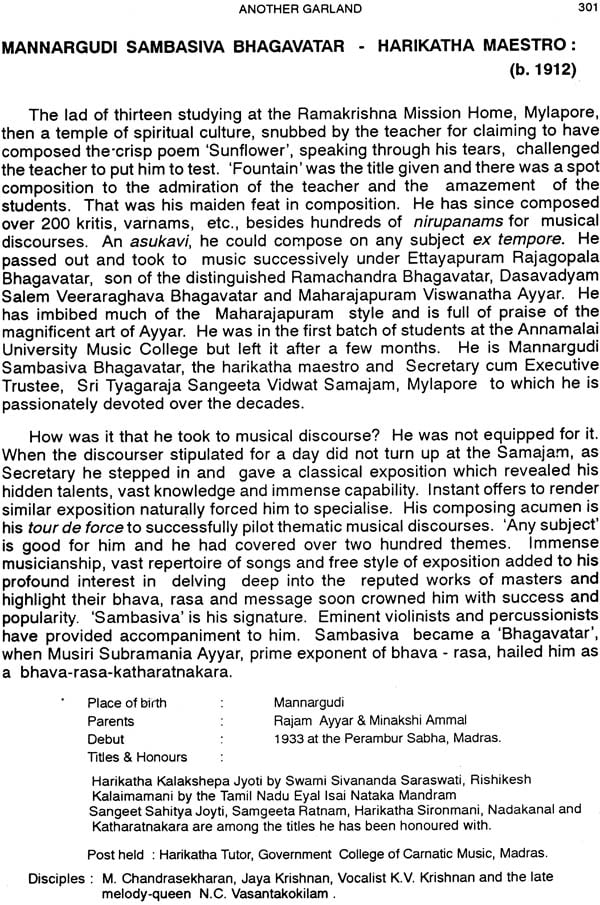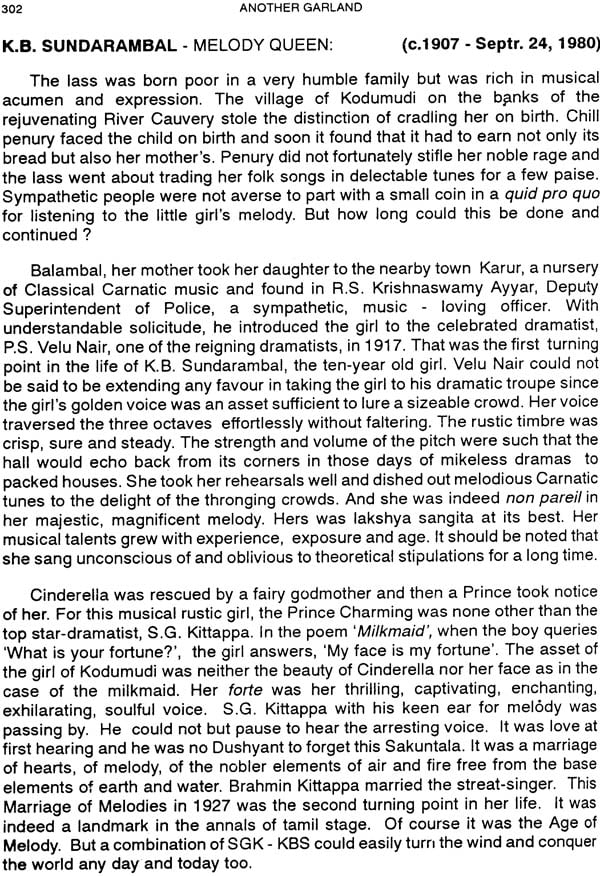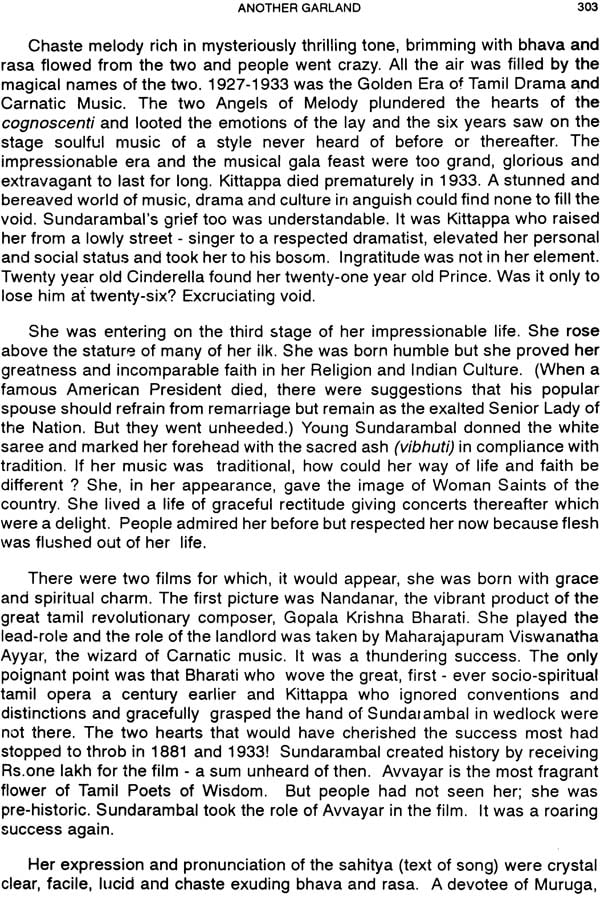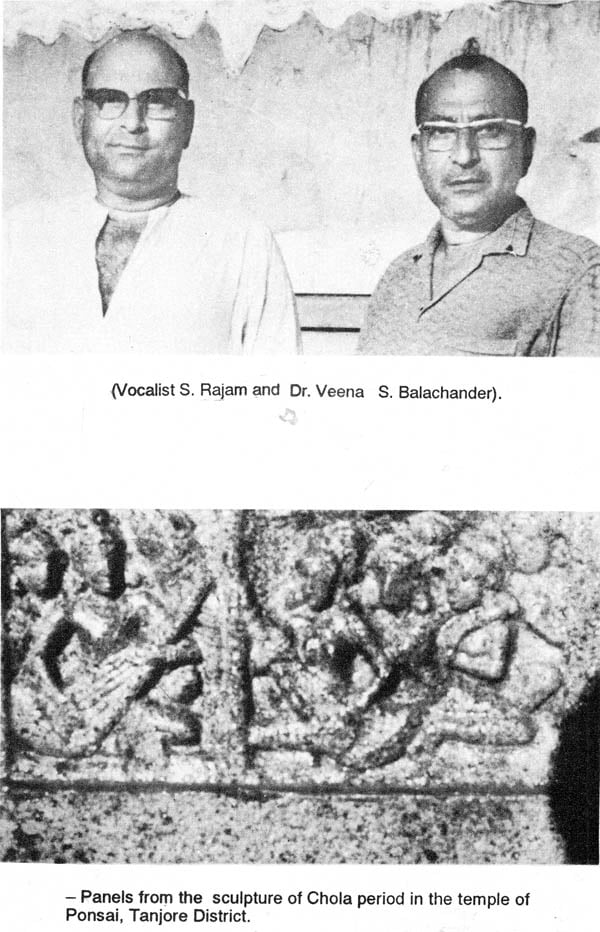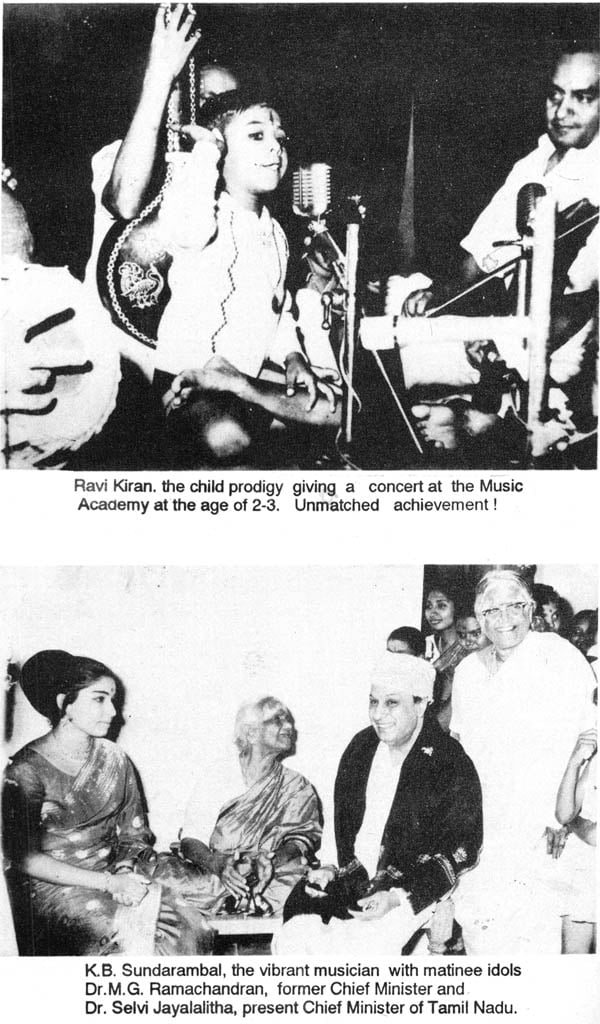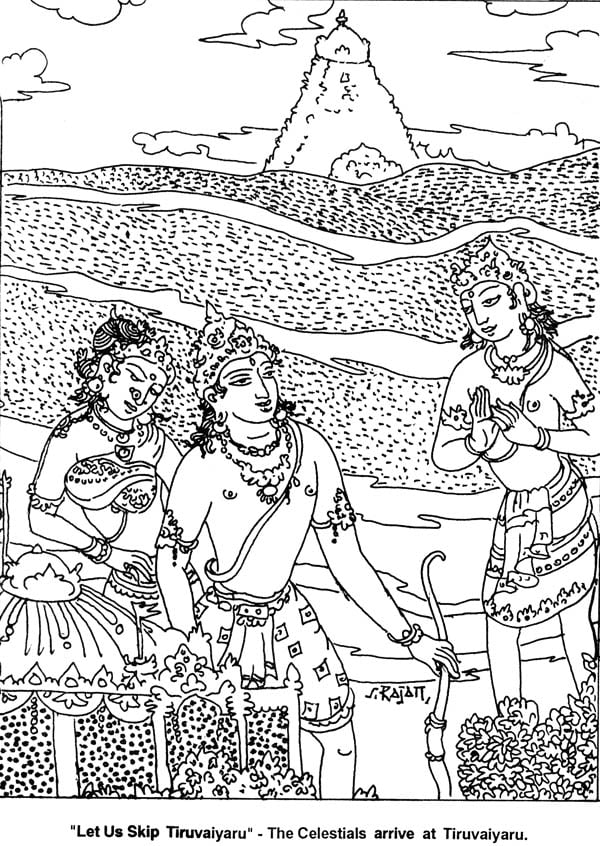
Another Garland : Biographical Dictionary of Carnatic Composers and Musicians (An Old and Rare Book)
Book Specification
| Item Code: | NAK933 |
| Author: | N.Rajagopalan |
| Publisher: | Carnatic Classicals, Chennai |
| Language: | English |
| Edition: | 1993 |
| Pages: | 528 (20 B/W Illustrations) |
| Cover: | Hardcover |
| Other Details | 9.5 inch X 7.0 inch |
| Weight | 920 gm |
Book Description
N. Rajagoplan was born at adthuraj, known not only for its vast freen carpet of paddy and plantain but also as an outlet to musical centres like Tiruvaduturai, Maruthuvakudi, Konerirajapuram, and Tirupanandal. Deeply devoted to his duties, he recalls his spell of service when he had the opportunity to put down illicit trade in alcohol ruthlessly. Had served in the erstwhile Board of Revenue, Secretariat and in districts. Retired from the Indian Administrative Service on October 31, 1981.
Had taken lead roles in amateur dramas in earlier years. Sangita Kalanidhi Papanasam Siva took him as his disciple but it ended when he had to concentrate on films. Rajagopalan resumed his training under Salem Subbarama Bhagavatar later but had to discontinue it. Resumed recently under Trichy P. R. Sundar Rajan. He imbibed his love of music from his mother who would sing melodiously even in her seventies and his deep sense of dignity, discipline and duty from his learned saintly father.
His ambition has been to bring to focus the valiant lives and the fragrant contribution of composers and musicians. ‘A Garland” was released in June 1990 and now ‘Another Garland’ is place before the public. The books are the results of strenuous work and undivided attention of years. He looks forward to take up work on ‘Yet another Garland’.
A galaxy of composers, musicians, musicologists and hymnodists have played a vital and impressive part in the evolution and development of the science and art of our Carnatic music - from Bharata, Narada and Illango to Ravi Kiran, U. Srinivas and Shashank. Magnificent artistes like Maha Vaidyanatha Ayyar, Tanjore Quartette, Arunachala Kavirayar, Gopala Krishna Bharati, Uthukadu Venkatasubba Ayyar, Papanasam Sivan, Vina Balachander, S.G. Kittappa and K.B. Sundarambal and the happily present vidwans like Semmangudi Dr. Srinivasa Ayyar, Dr. M.S. Subbulakshmi, Smt. O.K. Pattammal, Dr. Balamurali Krishna, Shri. Lalgudi Jayaraman and Prof. T.N. Krishnan have all played a highly distinguished part.
Shri. N. Rajagopalan has the credit of bringing out the first-ever gargantuan Biographical Dictionary of Carnatic Composers and Musicians in English titled , A Garland' in 1990 presenting exhaustive accounts of the lives of over seven hundred artistes. I find that it has been very well received and excellently reviewed by competent authorities. The author is following it up with his second book titled appropriately as ' Another Garland' containing over 350 lives. The two ' Garlands ' thus cover well over a thousand lives, a formidable number indeed!
The author, in his Preface, recalls the memorable words of Ben Johnson –
, For, where his person liv'd scarce one just age, and that, 'midst envy and parts; then fell by rage; His dream too dying.
To all future time, not only doth restore His life, but makes that he can die no more.'
The truth of the statement could not be better illustrated than by a Biographical Dictionary giving succinct accounts of the noble side of the lives of the devotees of Nada Yoga and Nadopasana. The articles in Part I of the Book and the notes in Part III present a wealth of information. Chronological table, definitions and index make it a complete source book of reference, a ready reckoner and a book of treasure. I congratulate the author for the immense labour and expense he has put in and for presenting this treasure for the reference of musicians, music-lovers, teachers, students and researchers. I am happy to commend this Another Garland to the musical fraternity.
I Commended the yagna of bringing out the first-ever, gargantuan Biographical Dictionary of Carnatic Composers, Vocalists, Instrumentalists, Musicologists and Hymnodists in the month of Margasirsha (Dhanus), extolled as the chosen month of God, December 1987. The first book titled 'A Garland' was graciously released by H.H. the Sankaracharya of Kanchi-Kamakoti Peetam, Sri Jayendra Saraswati Swamigal, as a Bharatiya Vidya Bhavan publication on June 19, 1990, the first copy being received by Sri Haridhos Giri Swamigal, perhaps the lone crusading Bhagavata Maha Purusha now. It covers the lives of over seven hundred artistes both of the illustrious past and the memorable present. It has been acclaimed as a definitive source book of reference, a monumental dictionary, a ready-reckoner and an unparalleled treasure. Excerpts of the reviews find a place in Part III F of this book. Since the first book could not naturally cover the galaxy in entirety, this second book titled 'Another Garland' is presented (to be followed by' Yet Another Garland' in due course since quite a number of artistes do not find time to give details).
Classical Carnatic music is but the continuance of ancient Indian music as it was prior to the advent of Persian influence and the attendant evolution of the Hindustani style. The tamil areas in the South had from pre-historic times a well-developed, scientific, distinct sytle known as Pann. The Indian (later called the 'Carnatic' from the days of the work Manasollasa) and the Tamil Pann had coalesced invisibly during the middle ages and presently the South has the Carnatic music and the North has the Hindustani music - of course, both raga-based with common and distinct features. The Garland Series brings to focus the illustrious lives of artistes expounding the Carnatic style.
Classical music in India has fundamentally been the handmaid of spiritual savants and apostles for self-realisation and propagation of spiritual message. Though for some music may be professional, it has continued to be subordinated to the primary, ambrosial objective of spiritual enlightenment and advancement. 'Our ancients realised (the power of music) almost at the very dawn of our history ... soon found that the Gods were more easily gratified by the singing of the poetic hymns called Riks and they produced the Sama Veda ... Bharata says that Brahma extracted the, art and science of music from Sama Veda. (Dr. V. Raghavan). If classical music is Nada Upasana for the yogi in musician, it is solace and soulful joy (brahmananda) both to the initiated and the lay. Fortunately education or training is no pre-requisite to surrender one's soul to melody. Aanaaya Nayanar's enchanting life (page 274 in A Garland) is an apt and ideal illustration and consummation of the magic lure and ennobling spell of melody.
Till the demise of the Second World War, the average Indian was basically wedded to spiritual endeavours to the neglect of materialistic pursuits and profit. The marriage of Man and Art was complete and harmonious and music flourished in a salubrious climate. The classical prospered with-the folk music side by side both being patronised by royalty, landed aristocracy and temples. All the air, the aroma of music held benevolent sway. In fact, music was prasada to one and all, high and low, copiously distributed irrespective of caste, creed or race as music was free for all like air and water. Temples reverberated with vocal and instrumental music daily. Dramas, concerts and dances were in the open dishing out classical music in plenty and continuously to reach every man at his home and street! Whether it be Ekadashi or Sivaratri, Rama Navami or Krishna Jayanti, marriage or funeral, success or defeat, music was made with foresight sine qua non. No nation or art can sustain itself nor can it flourish with dwarfs with a mere one or two of tall stature. Galaxy of giants appeared on the scene from time to time to rejuvenate the art and reorient the science - Vide the chronological table in Part IV. National genius presented successive waves of illustrious breeds of composers, musicians and musicologists who kept the musical fire and flame bright. The endeavour and vocation constituted a multi- dimensional effort to inculcate spiritual values, enlighten people, spread art and culture and incidentally provide occupation and entertainment nearer home. In fact the scheme of founding temples had the same profound socio-economic- cultural bias in India. That was the underlying concept of Village Swaraj pure and simple. Temples were the fulcra around which the lives of the people revolved. The environment was so sublime and all-pervasive that even a fanatic Aurangazeb could hardly find any means of avoiding and averting music and could not find the royal writ, place or the means to bury it. That was the prime reason for the monstrous intensity of his rage. There were fields of hereditary specialisation and implied division of labour as in the cases of hymnodists (odhuvars), nagaswara artistes and dancers. It is significant that renowned composers and musicians came up like the sixty-three Saivite Apostles (Nayanmars) from among the different strata of society since music was intrinsically a communal asset all along and free for all. That was Bharath, the Dharmabhoomi, the Mokshabhoomi wherein people from Nandanar to Narada flourished.
The reducing tempo of services and festivals at temples during the last four decades, the invasion and onslaught of mike-based cheap music, the migration of artistes to crowded urban centres and concentration of all musical endeavours in a few metropolitan centres robbed and deprived the millions in the vast slumbering rural tracts of all exposure to classical music leaving them musical agnostics. The shifting of music from temples and dramas from street corners and river beds to sabhas and chambers stifled the growth of classical music. Classical music can flourish in its native charm, grandeur and glory only in an atmosphere of vicrenti and not in the polluted, dusty turmoil of noisy towns and cities. The latter can hope to nourish it for a while but not nurse it through. As it is with grains and primary products, the city can consume but not hope to create music. Classical music based on improvisation has no future unless the imbalance is remedied and the rural reorientation is soon accomplished. George Ade said with rustic humour –
In the city, a funeral is just an interruption of traffic; but in the country, it is a form of entertainment. '
Even so, rural India certainly provides the appropriate environment and atmosphere needed and the psychological and emotional, mental and moral influences for inculcating and imbibing music. The ultimate marketing may be in urban and rural centres but training and apprenticeship should be rural-oriented.
To subserve this, corporate aids and scholarships are to be canalised to restore to rural areas their legitimate share of music schools, concerts, fairs and festivals. Temples should play their part as before and youth associations should distribute their services and concerts among rural centres. Urban monopoly, urban-oriented artistes with one leg in music and another in jobs and casuals can never sustain the soul of the art for long. The tragedy of sickness overtaking the ambrosial, divine classical art has to be averted.
As stated above, rulers and landed aristocracy vied with each other in their patronage of composers and musicians and the cyclical patronage of royal courts at Vijayanagar, Tanjore, Trivandrum, Pudukottai, Mysore, Ettayapuram, etc., is worthy of being written in letters of gold. Temples provided the basic stamina at grass roots to nagaswara artistes and hymnodists in general and other musicians at festivals. These lent name, fame and stature to the artistes without doubt. It is also an undeniable fact that most of the artistes lived strangers to material affluence. They forgot their pangs of poverty and pain of hunger in yogic pursuits in the realm of melody. As beautifully observed by M.S. Golwalker:
'India opted for the wealth of perfection, virtues and sublimity of the soul, which is real and abiding; and no wonder great heroes and monarchs have worshipped the dust of the feet of half-naked sanyasins who rose above selfish interests in the cause of humanity.'
The prime beneficiary, the Indian Society had the vision and nobility to glorify Eminence entrenched in Indigence and raised to immortality the dichotomy of nebulous earthly existence and weighty contributions in art, science and literature and their coparcenary. The torch-bearers of Classical music took pride in such a paradoxical existence; and unselfish nadopasana took music not only to the temple prakaras and bhajan mandals quantitatively but also to the pinnacle of excellence and public acknowledgment as if in a quid pro quo. The position is not much different even now. A few musicians may, perhaps, revel in comparative prosperity; quite a number stand stopped at the portals of affluence while a vast majority have little access to it.
It is a tragic fact of life that luck, opportunity and patronage bless but a chosen few. Taking public life for comparison, Satyamurti, connoisseur, office-bearer of the Music Academy, Madras and the most remarkable parliamentarian was not destined to become a Chief Minister as hoped for. Sardar Patel shaped Independent India but was not chosen for conferment of Bharat Ratna till at last he was found fit forty-five/years later by a minority government for posthumous honour! Lal Bahadur Sastri ascended the gadi but the cruel hand of Death sniffed out his life at the time of his glory on alien soil. How many V. I. PS, visit his samadhi? That Simizhi Sundaram Ayyar, Mudicondan Venkatarama Ayyar and a host of others were side-lined is well-known. The Garlands shall accord them a true berth since, in the words of Ben Johnson, -
“For, where his person liv'd scarce one just age, and that, 'midst envy and parts; then fell by rage; His deeds too dying.
To all future time, not only doth restore His life, but makes that he can die no more."
Rulers and Aristocracy were not necessarily the standard-bearers of culture. In India, it was the saint, sage and the artiste, who 'rose above the mundane temptations of pelf and power' and dedicated their all to art, culture and society, that were the torch-bearers. The 'gurukulavasa' scheme was born out of this lofty inspiring climate. It prospered here from before the days of the Ramayana and the Mahabharata till it was strangulated in the recent past and with it went the unique blend of the sire-son relationship with the boon of the teacher-student nexus. At Kurukshetra, when Arjuna directed the first five arrows to the feet of Bhishma, the charioteer felt amused but the wise Bhishma exclaimed, 'My beloved Arjuna is prostrating before me with all his five pranas seeking my blessings'. Arjuna entertained the same respect to his preceptor Orona. Fortunately we have amidst us some elder musicians who had tasted the rigours and fruits of the now defunct system and it has been my earnest endeavour to bring their lives to record. The difficulty lies in getting the details since, in the words of Sir C. P. Ramaswami Ayyar, 'The self-imposed anonymity and self-effacement of Indian Art is one of the standing miracles of all times'.
Some top musicians introduced novelties in presenting concerts during the Music Festival 1991-92 with orchestra as we have had brief spells of Rajarathinam with tambur and mridangam, Sarabha with tavil (of course, unavoidably), Kunnakudi Vaidyanathan and Mandolin Srinivas with tavil. A Bangalore artiste is reported to be giving Classical Carnatic music concerts to the beat of jazz percussion and jazz band! Of course, it may be argued that one worships the Lord Siva and not the cordon of demons (boothaganas), prostrates before the deity and not the palanquin-bearers and pays obeisance to the guru-saint and not those who fan him; and likewise the principal artiste and his contribution alone should count. But the quality and the strength of accompanists do contribute much to the wealth of the music rendered, to the success or otherwise of the concert in bringing out the soul of music to elevate, ennoble and enlighten the audience. 'The despicable reed survives the storm as it sways with it but the mighty oak falls as it stands rigidly.' Classicism has a science, tradition and an image with consequential constraints and need to safeguard its purity and integrity. Orchestra may entertain but Classical music enlightens and elevates. How far the infiltration of orchestra could be countenanced is to be analysed to guard against the mighty oak falling down. Crude experiments may be injurious because of imitation and profit. A patient was emotionally shattered driven by the illusion of the nearby banyan tree crashing down on his head. To disabuse his mind, the tree was stealthily removed when he was under anaesthesia. Startled to see it absent on waking up, the poor man screemed, 'Lo ! you had fallen on my head and crushed it !' and died of shock. Let not noisy orchestra annihilate the mild and soft classical breed based on improvisation.
I solicit a reference to my preface to the first book (reproduced next). A glossary, chronological table of artistes, bibliography, definitions and an index to biographies in both the books find place in Part IV to assist musicians, music-lovers, students and researchers.
Part III-F carries an addenda and corrigenda to 'A Garland' updating the details which may be read as part of the first book. They will be incorporated in the revised edition of Book I.
The period 1990-1992 has witnessed many renowned musicians bidding adieu to the stage of Classical Carnatic music. Dr. Semmangudi Srinivasa Ayyar, the senior-most Sangita Kalanidhi and veteran hailed as the 'Bhishma', announced his retirement in April 1992 after sixty-six eventful, record-breaking performing career. He commenced his career in 1926, one year earlier to the advent of the Music Academy, Madras and perhaps he is the first great artiste who has announced his retirement! Where is the question of retirement in politics and music? His announcement is without doubt historic! (I have a particular interest in this as he happens to be the 'son-in-law of my village', if the expression is permissible.) May the sage-counsel of the maestro continue to be available as his retirement is only as a performing artiste.
D.K. Jayaraman, a Sangita Kalanidhi, the soft prince among prominent musicians died unfortunately in January 1991 - just seventeen days after he was crowned at the Music Academy leaving scores of disciples and a vast assembly of admirers, 'whose pang is bitter, oft-times bitter, when they recollect his loss'. Dr. M.L. Vasanthakumari, another Sangita Kalanidhi and one of the performing Lady-Trinity, left on October 31, 1990 to be one of God's chorus celebrities and present Dasanjali for a change, leaving a large concourse of admiring and passionate disciples and well-meaning rasikas in India and abroad.
| Srimukham of H.H. Sri Jayendra Saraswati Swamigal, Sankaracharya of Kanchi-Kamakoti Mutt | 2 | |
| Foreword | 3 | |
| Voice of Divinity | 4 | |
| Preface | 5 | |
| Preface to 'A Garland' (First Book) reproduced | 11 | |
| Acknowledgements | 16 | |
| Dedication | 17 | |
| List of Illustrations | 18 | |
| Table of Contents | 19 | |
| Part I | ||
| I | Tamil Isai | 23 |
| II | Raga - An Intellectual Property? | 30 |
| III | Women in Melody | 33 |
| IV | Trends and Trends | 39 |
| V | Jealousy - The Arch Destroyer | 44 |
| VI | Nadopasana is Transcendental Bliss | 49 |
| VII | Contests and Challenges - II | 52 |
| VIII | Purandara Dasa Challenged | 62 |
| IX | Classical Extravaganza | 68 |
| X | A: Climactic Dazzle | 71 |
| B: Man's Admiration for the Supreme - By Prof. (Dr.) B. Ramamurthi | 72 | |
| XI | Cradles of Music - II | 74 |
| XII | Soul of Eminence is Immortal. | 77 |
| XIII | Let us skip Tiruvaiyaru - A Farce. | 78 |
| Part II | ||
| Biographical Sketches of Carnatic Composers, Vocalists, Instrumentalists, Musicologists, etc. | 85 | |
| (Combined Alphabetical Indices for Book I and Book II are given in Part IV.) | ||
| Part III | ||
| A. | Great Events, Memorable Performances and Unique Records. | 346 |
| B. | Deeds, Thoughts and Sayings | 368 |
| C. | Aphorisms and Epigrams | 383 |
| D. | Interesting Notes and Incidents | 395 |
| E. | Musicians and Music | 430 |
| F. | Addenda and Carrigenda to Garland (Book I) | 447 |
| Part IV | ||
| A. | Glossary | 474 |
| B. | Bibliography | 483 |
| C. | Chronological Table of Composers, Musicians, Etc., (Book I and Book II Consolidated) | 489 |
| D. | Index to Individual Biographies In Part II (Book I and Book II Consolidated) | 505 |
